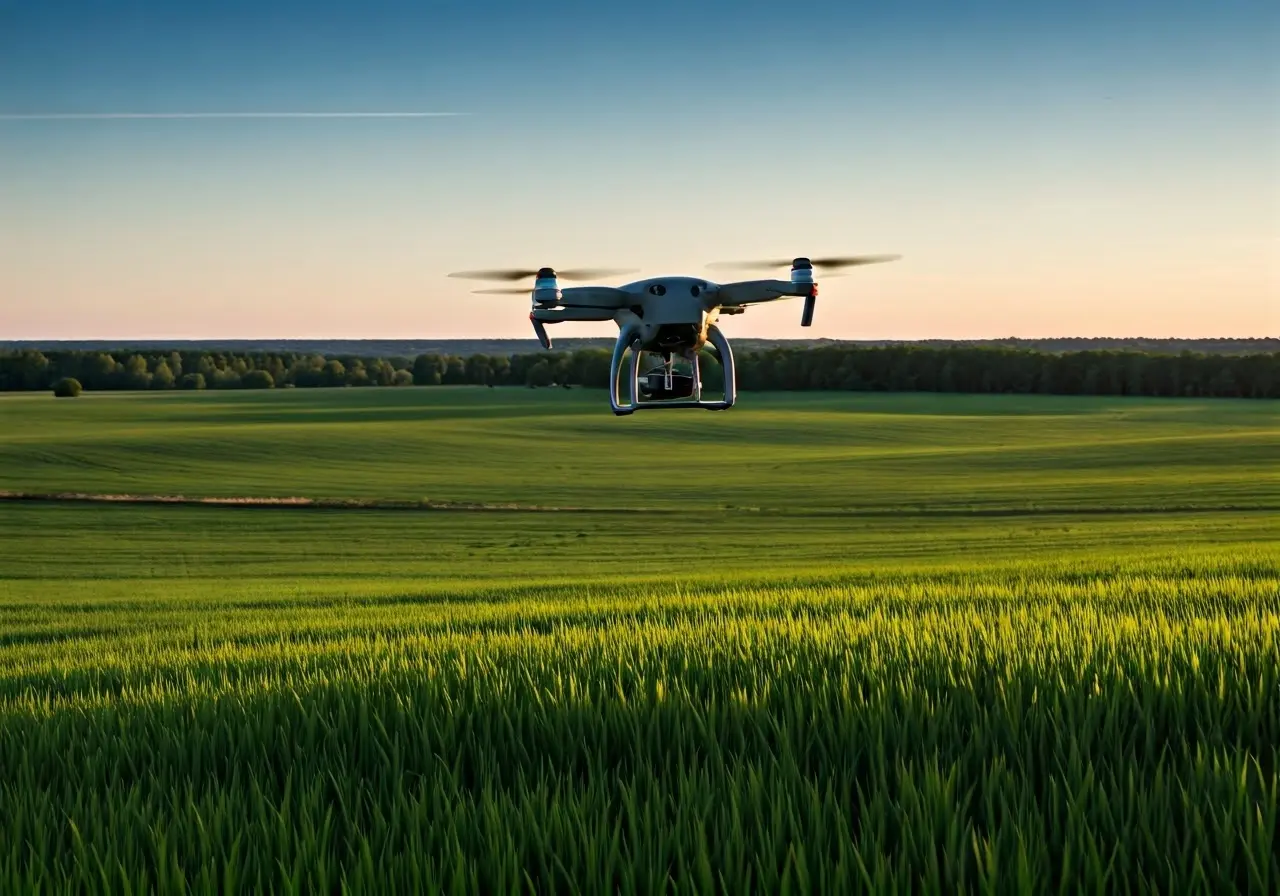
10 Ways Drone Based Agriculture is Revolutionizing Farming Practices
Share
In recent years, agriculture has undergone a significant transformation, with cutting-edge technologies like drone-based agriculture leading the way. These technological marvels are not just flying gadgets; they are reshaping the way farmers grow crops, monitor fields, and ensure sustainable agriculture. In this blog, we’ll explore the various ways drones are revolutionizing farming practices, making it more efficient and productive.
1. Transforming Crop Monitoring
Drones allow farmers to keep a close watch on their crops from above, making monitoring easy and efficient. By capturing high-resolution images, drones help in detecting crop health issues before they become serious problems. This ability to oversee large areas swiftly can lead to the timely identification of infestations or diseases, improving the overall health of the farm. The data acquired by drones offers invaluable insights, facilitating proactive measures that protect crops and optimize yields. As farmers transition to drone-assisted monitoring, the reliance on traditional labor-intensive methods lessens, allowing them to invest in other critical aspects of their operations. This shift not only ensures efficient monitoring but also enhances the farm’s capacity to respond swiftly to any anomaly, thereby securing the crops from potential threats.
Drones, equipped with advanced sensors, can detect variations in plant color and health, indicative of stress caused by pests or nutrient deficiencies. This kind of analysis used to require manual inspections that were time-consuming and often less accurate. Now, with transformative drone technology, data collection happens in real-time, providing a constant stream of up-to-date information to make informed decisions rapidly. These aerial insights empower farmers to pinpoint specific areas needing attention without unnecessary resource expenditure. Essentially, drones offer a bird’s eye view of the farmland, revealing patterns and trends invisible to the naked eye. Through this advanced form of monitoring, farmers can ensure their fields remain at peak condition, ultimately leading to stronger and healthier harvests.
2. Precision Farming Techniques
With the integration of drones in agriculture, precision farming has become a reality. They help in applying fertilizers, pesticides, and water with exactitude, ensuring that crops get just what they need to thrive. Precision agriculture leverages data and technology to optimize field-level management concerning crop farming. Drones act as the delivery mechanism for precision farming, effectively bridging the gap between information and application. By accurately measuring variables such as crop biometric parameters and soil moisture levels, drones can guide resource application more accurately than ever before. This tailored approach results in enhanced productivity while conserving essential inputs, directly benefiting the farmer’s bottom line.
Precision farming also facilitates site-specific management. By identifying nutrient needs on a micro-level, drones ensure that every square meter of farmland is optimized for maximum no-waste output. This method not only addresses over-fertilization and under-fertilization issues but also inherently reduces run-off that might contaminate waterways. The intelligence of these flying allies is amplified by their ability to provide actionable insights, minimizing guesswork and improving overall farm inputs. The integration of drone technology into precision agriculture marks a significant step toward agricultural sustainability, balancing economic and environmental needs seamlessly.
3. Efficient Field Mapping
Drones provide accurate aerial field maps that are crucial for understanding soil variability and planning farming activities, leading to better crop yields and reduced wastage. This sophisticated mapping allows farmers to analyze field conditions like never before, highlighting areas that require specific attention or treatment. By using software that translates drone-captured data into actionable maps, farmers can visualize their land’s terrain, identify problem areas, and even model water runoff scenarios. The precision with which drones map out these areas ensures that no detail goes unnoticed, leading to well-informed strategic decisions.
Field mapping through drones transforms conventional approaches by offering insights that maximize efficiency and productivity. Detailed topographical information allows for calculated cultivation, aiding in the precise layout of crops and related infrastructure improvements. The application of crop management software turns raw data into insights for growth predictability and pest surveillance, among other aspects, refining the general approach toward modern agriculture. Field mapping drones not only provide data but empower farmers with knowledge, setting new standards for agricultural accuracy and success.
4. Saving Time and Labor
By automating tasks such as planting, seeding, and spraying, drones save time and reduce the need for labor, allowing farmers to focus on more strategic aspects of their operations. With precise scheduling and execution, farm labor is redirected towards specialized tasks. The automation capabilities of drones allow for faster completion of repetitive tasks, reducing the human workload and freeing labor for innovation-driven projects. As these unmanned aerial vehicles carry out monotonous chores, farmers are empowered to redirect focus toward the strategic development of their enterprise, increasing both efficiency and workflow satisfaction.
The operational versatility of drones enables a shift from labor-intensive practices towards advanced technological operations. This fosters an environment where creativity and efficiency in farm management flourish, offering benefits that extend far beyond mere labor reduction. Each facilitated task—whether it be intricate spraying, equitable seeding, or effective planting—sharpens the focus on the overall strategic objectives of farming. As technology dictates the basic operations, farmers become free to conceptualize and execute plans that have the potential for increased growth and sustainability, marking a definitive step towards progressive agricultural ventures.
5. Enhanced Data Collection
Drones gather vital data on crop conditions which enable informed decision-making. This data-driven approach helps farmers to optimize their output and plan better. By harnessing the power of detailed aerial imagery, drones provide an unprecedented level of insight into every aspect of crop management. These insights translate into smarter resource use, as drones offer real-time data to tailor specific care for overlapping zones and sensitive areas. With this kind of advanced monitoring, farmers bear the torch of precision into future advancements, crafting pathways to efficiency and environmental harmony.
Enhanced data collection through drones represents a shift towards intuitive and timely agricultural practices. The robust analytical capabilities of drones enable farmers to anticipate the needs of their crops accurately, leading to improved growth cycles and optimal yields. The wealth of data collected at each flight informs decisions regarding irrigation, fertilization, and pest control. Through this intelligent intersection of technology and agriculture, drones fine-tune the precision of farm management while ensuring sustainability. Ultimately, drones enable farmers to see what was once hidden, bridging the gap between optimization and opportunity.
6. Pest and Disease Management
With drones, it’s easier to monitor pest and disease outbreaks. Early identification can lead to swift action, preventing widespread damage to crops. Through their high-tech imaging and sensors, drones identify anomalies in crop coloration and structure that could signify pest intrusion or disease presence. Such early warnings allow farmers to implement targeted interventions, curbing outbreaks before they impact larger farm areas. This proactive management approach reduces the need for broad-spectrum pesticide applications in favor of precise, localized treatments.
The intelligence of drones in monitoring crop health introduces a new realm of responsive farming strategies. These flying tools offer solutions by scanning large tracts of land swiftly while collecting detailed health data on a plant-by-plant basis, capturing any signs of anomalies or stress. With the ability to implement site-specific treatment programs, drones foster a more balanced and sustainable use of agricultural chemicals. Through this meticulous understanding of crop conditions, drones enable effective pest and disease management plans that safeguard farming productivity and sustainability.
7. Improving Irrigation Efficiency
Equipped with thermal cameras, drones can identify areas that need water, allowing farmers to improve irrigation efficiency and conserve water resources. By employing portable aerial viewpoints, drones provide an in-depth inspection of irrigation anomalies that often remain unseen at ground level. These insights are fundamental to recalibrating water distribution, prompting the strategic direction of irrigation lines. By targeting dry patches promptly and adjusting levels as needed, drones usher in an era where water conservation aligns harmoniously with crop needs.
The utilization of drones in irrigation management optimizes resource allocation, balancing the need to support thriving crop growth and reducing water waste. Drones are capable of capturing elevated views of moisture levels across the fields, profoundly affecting farmers’ potential to tailor their irrigation habits. These vigilant skyward observers transition into trusted navigators, bridging the existing gap between human intuition and technological perfection. Through the reinforcement of sustainable irrigation practices, drones sustain healthier crops and a verdant farming landscape.
8. Environmental Benefits
By minimizing chemical use and planning efficient field operations, drones contribute to reduced environmental impact, promoting sustainable agricultural practices. Innovations like precision targeting in application lead to reduced exposure to non-target areas, preserving beneficial insect populations and fostering biodiversity. This mindful approach preserves the nutritional balance of the agricultural ecosystem and prevents chemical runoffs into water bodies, demonstrating a responsible and conscious farming practice that respects and nurtures natural ecosystems.
Drones drive agricultural sustainability by accelerating the industry’s progression toward greener methodologies. The thoughtful application of chemicals directly translates into a lighter load on the environment, minimizing adverse impacts. The ability of drones to implement precision farming techniques ensures that each step taken towards crop care is aligned with ecological consciousness. Through these practices, drones double as instruments of agriculture and guardians of the planet, delivering productivity with a keen regard for environmental preservation.
9. Monitoring Livestock
Drones also offer great help in livestock management by monitoring their health and ensuring their numbers, making animal husbandry more precise. Equipped with advanced sensors and high-resolution cameras, drones provide farmers with a comprehensive overview of livestock herds, capturing critical information about animal well-being and behavior. These insights, otherwise hard to obtain via traditional means, enable earlier intervention if issues arise, thereby safeguarding livestock health and enhancing productivity across animal husbandry operations.
10. Disaster Response and Recovery
In the event of natural disasters, drones can quickly assess damage to crops and assist in recovery efforts, offering farmers practical support in difficult times. Their nimble ability to access hard-to-reach areas quickly ensures that farmers can evaluate and document the extent of damage extensively, facilitating efficient resource allocation for recovery. The visual data compiled by drones provides decision-makers with vital information needed to prioritize responses, minimizing the disruption caused by unexpected natural events.
Drones redefine disaster management by transforming tasks such as damage assessment and recovery planning into deft, technology-driven processes. Their real-time capabilities and extensive range enable comprehensive site assessments, ensuring prompt and informed recovery strategies. By supporting farmers in overcoming the fallout of disaster scenarios, drones catalyze the resurgence of normalcy, fortifying agricultural resilience and safeguarding livelihoods against future uncertainties.

